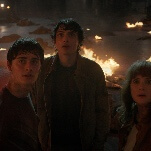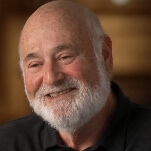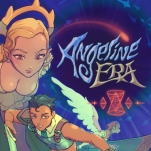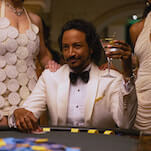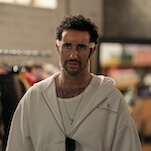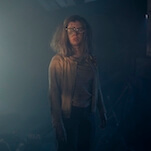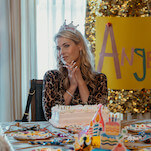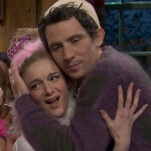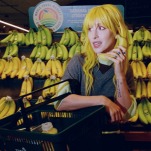The romantic comedy genre is famous for Type-A women. As any Hallmark Christmas movie fan can tell you, the prototypical rom-com heroine is someone who has her life too together, to the point where she needs a carefree man to come shake up her routine. What made Bridget Jones’s Diary such a breath of fresh air in 2001 is how it flipped that trope on its head. Renée Zellweger’s Bridget Jones is a hapless, uncouth, but ultimately lovable hot mess who needs to mature a bit, sure, but is ultimately deemed perfect just as she is. It’s her love interest Mark Darcy (Colin Firth) who’s the Type-A stick-in-the-mud who needs to learn to loosen up and have a little fun.
Not only is Bridget Jones the patron saint of 30-something singletons, she’s also an icon for messy, self-deprecating women who don’t see themselves reflected in Meg Ryan’s finicky When Harry Met Sally restaurant orders or J.Lo vacuuming her curtains in The Wedding Planner. It’s a setup that leads to the pitch-perfect rom-com ending of the first Bridget Jones movie, in which an underwear-clad Bridget kisses her persnickety Prince Charming on a snowy London street corner. But it’s also a characterization that becomes a whole lot thornier (for better and for worse) when it’s stretched across four films over three decades—including the upcoming Bridget Jones: Mad About The Boy, which hits Peacock on February 13.
That’s because, at their core, most rom-coms are really just coming-of-age stories for adults. We watch two imperfect people mature into better versions of themselves through the power of love. And we generally like to imagine that those new, better versions are who they’ll go on to be forever. It’s one of the reasons there are so few rom-com sequels. It’s not fun to think about whether Andie and Ben could actually make it work in How To Lose A Guy In 10 Days, so Hollywood prefers to just reteam the same actors for a brand-new love story instead. (Not just Kate Hudson and Matthew McConaughey, but also Julia Roberts/Richard Gere, Adam Sandler/Drew Barrymore, Emma Stone/Ryan Gosling, and Taye Diggs/Sanaa Lathan, to name a few.) While there’s an occasional sequel like The Princess Diaries 2, which introduces a whole new love interest, our biggest rom-com franchises mostly just go on to become broader ensemble comedies, like My Big Fat Greek Wedding, The Best Man, Legally Blonde, and Mamma Mia!
Bridget Jones is different, however, partially because there was more source material to work with. The character first sprang to life in Helen Fielding’s semi-autobiographical column in The Independent before going on to feature in Fielding’s best-selling novels Bridget Jones’s Diary in 1997 and Bridget Jones: The Edge Of Reason in 1999. When director Sharon Maguire’s big screen adaptation of the first book became a box office smash and earned Zellweger an Oscar nomination, it only made sense to adapt the second book as well. And 2004’s Bridget Jones: The Edge Of Reason set the template for what all future Bridget Jones sequels would look like: movies in which Bridget winds up single and confused, torn between two potential love interests, only to settle on a “happily ever after” that really only lasts until the next film.
In Edge Of Reason, it’s Hugh Grant’s caddish Daniel Cleaver who returns to stir things up again after his scene-stealing turn in the first film. By that point, though, the film has already made the case that maybe Bridget and Mark aren’t such a well-suited couple after all. Though the story picks up just six weeks after the end of the first movie, cracks are already starting to show in their fairy tale romance. He’s been reset into his most stereotypical uptight mode, while she’s deeply insecure over fitting into his upper-crust world. The miscommunications and mixed signals that are so charming in their initial meet cute become cringe-worthy as they continue into their actual relationship. (For some reason Bridget is obsessed with whether Mark is going to propose to her, even though they haven’t even said “I love you” yet.) When Mark and Bridget break up over a pregnancy scare that brings their differences to the forefront, it makes sense. Maybe their relationship was only ever a pipe dream between two incompatible people with great chemistry.
Edge Of Reason ultimately makes the opposite argument, that Bridget and Mark’s breakup was the blip and they actually are meant to be together. “Bridget Jones has cocked things up for the very last time,” her voiceover promises as they walk off into the sunset together. But the 2016 sequel Bridget Jones’s Baby makes the bold choice to turn the messy subtext of Edge Of Reason into actual text. Though 43-year-old Bridge has gotten her life together in some ways (she’s working as a high-powered news producer and is finally “down to [her] perfect weight”), it turns out she and Mark didn’t make it work after all. Instead, they “went round and round for the best part of 10 years without ever making it across the finish line.” As the film starts, Bridget is still single and Mark is married and on the verge of his second divorce. “We always loved the fantasy of us,” she tells him when they reconnect at a friend’s party. “But the reality, as we both know, is quite different.”
The first time I watched Bridget Jones’s Baby, I found it kind of depressing that this rom-com couple I’d loved for 15 years weren’t still together. And it’s hard not to feel the hand of cheap formula demands at play when it comes to that decision. The Bridget Jones series loves a high-stakes love triangle with a climatic finale. Here it’s Patrick Dempsey who steps in to vie for Bridget’s hand as one of the potential fathers of her unplanned pregnancy, even as the film ultimately reaffirms that Mark really is the love of her life. Yet that desire to bring sweeping romance to the forefront of each individual film means the overall arc of Bridget’s life is anything but a fairy tale.
The longer I’ve sat with the series, however, the more I’ve come to appreciate that messiness. Not everyone gets a fairy tale romance in real life, and as a rom-com heroine who’s specifically designed to be realistic and relatable, perhaps it’s fitting that Bridget doesn’t either. “Can’t go back and keep making same mistakes,” she jokes in her diary. “Must keep moving forward and make new ones!” It’s an optimistic take on the “unlucky in love” trope from a franchise that’s always understood that Bridget’s friends, family, career, and sense of self-worth are just as important as her love life.
While Bridget Jones’s Baby gives Mark and Bridget plenty of sweet, wistful romantic moments that call back to his iconic “I like you very much, just as you are” speech from the original film, the movie’s most moving line is about Bridget herself. At the height of the paternity drama, Bridget’s obstetrician Dr. Rawlings (co-writer Emma Thompson) warmly reminds her, “You’re absolutely capable of doing this on your own.” And while the film does end with Bridget and Mark getting married, returning director Sharon Maguire seems to realize that the heart of the series has shifted. The final shot is of Bridget in her wedding dress, walking off into the sunset with her toddler in one hand and a glass of champagne in the other—a reminder that the only thing she truly has to rely on in life is herself.
The fourth film seems to continue that theme, picking up in a future where Mark has died and Bridget is left as the widowed mother of two children. It’s a tragedy (and a controversial choice when Fielding wrote it into her 2013 novel), but it also feels weirdly fitting for this odd journey Bridget has been on over the past three decades. This time around it’s the much younger Roxster (Leo Woodall) and the refined Mr. Wallaker (Chiwetel Ejiofor) who are vying for her affection. Yet, if this film is anything like the previous ones, it’ll be Bridget who’s really front and center—processing her grief and falling in love again with the same warts-and-all frankness that Fielding has described as the “gap between how you feel you ought to be and how you actually are.”
In a media landscape that’s more than happy to celebrate men with Peter Pan syndrome, it’s refreshing to see a woman in her 30s, 40s, and beyond whose messy flaws are seen as sympathetic and likable. The original Bridget Jones set out to tell the story of a lovable woman who doesn’t quite have her life together and the series has stuck with that theme for 24 years. Bridget may never entirely grow up and settle down, but maybe she doesn’t need to. With or without a romantic partner, we still love her, just as she is.





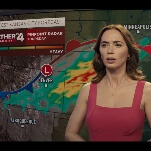
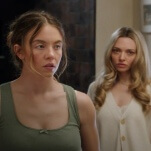
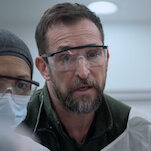

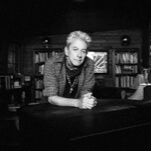



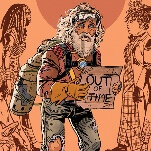


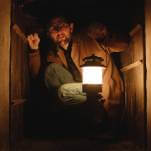



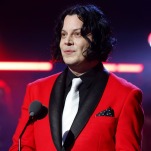

![Rob Reiner's son booked for murder amid homicide investigation [Updated]](https://img.pastemagazine.com/wp-content/avuploads/2025/12/15131025/MixCollage-15-Dec-2025-01-10-PM-9121.jpg)

